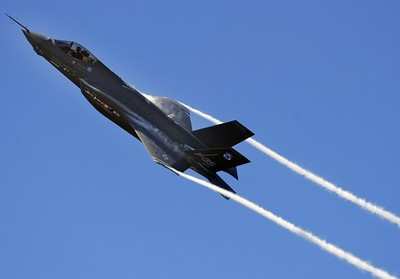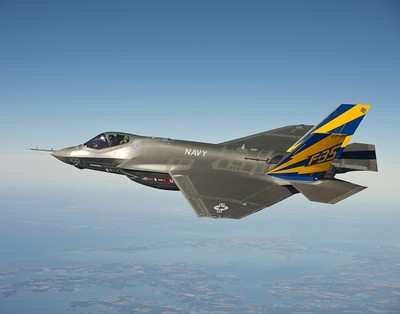Achieves Major Milestone For 2011
One of five milestones established by the Joint Program Office
for the F-35 for 2011 has been reached with the successful
completion of static structural testing on the airplane. The
testing is used to verify the structural integrity of the airframe
and to ensure specifications outlined in technical drawings used to
produce the aircraft are accurate. Engineering teams at Lockheed
Martin, BAE Systems, Northrop Grumman and the Joint Program Office
conducted the tests over the past two years.

In static structural testing, external loads designed to
simulate the pressures of full envelope flight conditions are
applied to hundreds of points on the airframe using an integrated
system of load pads, hydraulic actuators, air pressurization
mechanisms and reaction channels. As proof that the airframe is
capable of withstanding the pressures associated with the full
flight envelope, engineers tested the structure to 115 percent of
requirements and confirmed that no detrimental deformation of the
structure occurred. In the final phase of static structural
testing, the airframe was pushed to 150 percent of requirements to
verify that there was no rupturing or structural failure.
"As one of our major program milestones, the completion of
static structural testing demonstrates the significant progress
that we're making on our joint mission to field this 5th Generation
air combat capability," said Larry Lawson, executive vice president
and general manager of the F-35 program. "These successful tests
bring us one step closer to delivering the F-35 into the hands of
the men and women of our U.S. and allied forces."
Bob Burt, director of F-35 Structures Development added, "This
is a significant accomplishment for the F-35 program. Working
together with our partners at BAE Systems, Northrop Grumman and the
Joint Program Office, we successfully completed the static
structural testing ahead of schedule."

Prime contractor Lochkeed Martin has released an update on the
overall progress of the program. The company says the F-35 system
development and demonstration (SDD) flight test remains on or ahead
of plan for 2011, despite 15 days of testing lost due to fleet
stand-down after a ground mishap involving the Integrated Power
Package (IPP). Flight testing was also interrupted at Naval Air
Station (NAS) Patuxent River, Md., because of an Aug. 23 earthquake
and severe weather associated with Hurricane Irene. During this
period of down time, the flight test teams at all locations
continued working through planned modifications and
maintenance.
As of Aug. 31, the company says the fleet remained 8 percent
ahead of plan in year-to-date (YTD) flights. Several flight test
and production key milestones were accomplished since the last
report:
- BF-1 performed a 40 foot hover in calm winds and two vertical
landings (VL) for the 150th VL to date on Aug. 31.
- AF-10 and AF-11 were delivered to Eglin AFB, Fla., Aug. 31.
They join AF-8 and AF-9 assigned to the 33d Fighter Wing.
- Static testing was completed on the F-35C Lightning II carrier
variant (CV) ground article CG-1 at Lockheed Martin Fort Worth,
Texas, Aug. 29. With this achievement, the F-35 Program has
accomplished its static structural testing milestone for 2011.
- Jet Blast Deflector (JBD) testing was completed by F-35 CV
aircraft CF-2 at Joint Base McGuire-Dix-Lakehurst, N.J. from June
25-August 13. CF-2 successfully completed this portion of JBD tests
required to ensure the F-35C is compatible aboard an aircraft
carrier.
- AF-7 completed its last flight of currently required
conventional take off and landing (CTOL) maturity flights on Aug.
31.
Throughout the entire flight test program:
- F-35A conventional takeoff and landing (CTOL) jets have flown
314 times.
- F-35B short takeoff/ vertical landing (STOVL) aircraft have
completed 226 flights.
- F-35C carrier variant (CV) jets have flown 102 times.
From the start of flight testing in December 2006 through
September 16, 2011, F-35s flew 1,202 times, including the
production-model flights and AA-1, the original flight test
aircraft.
 ANN's Daily Aero-Linx (05.06.25)
ANN's Daily Aero-Linx (05.06.25) ANN's Daily Aero-Term (05.06.25): Ultrahigh Frequency (UHF)
ANN's Daily Aero-Term (05.06.25): Ultrahigh Frequency (UHF) ANN FAQ: Q&A 101
ANN FAQ: Q&A 101 Classic Aero-TV: Virtual Reality Painting--PPG Leverages Technology for Training
Classic Aero-TV: Virtual Reality Painting--PPG Leverages Technology for Training Airborne 05.02.25: Joby Crewed Milestone, Diamond Club, Canadian Pilot Insurance
Airborne 05.02.25: Joby Crewed Milestone, Diamond Club, Canadian Pilot Insurance




